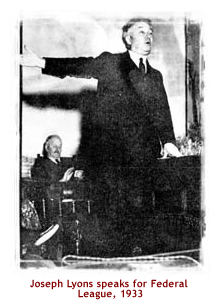 |
Joseph Lyons (1879-1939)
 Joseph Lyons was Australia's Prime Minister at the peak of the
secession movement. He, and other eastern States visitors, faced rowdy and
sometimes angry crowds during the 1933 referendum campaign.
Joseph Lyons was Australia's Prime Minister at the peak of the
secession movement. He, and other eastern States visitors, faced rowdy and
sometimes angry crowds during the 1933 referendum campaign.
Born in Stanley, Tasmania, Lyons worked as a school teacher before entering
the Tasmanian Parliament as the Labor member for Wilmot in 1909. After serving
as Premier of Tasmania between 1923 and 1928, Lyons moved to Federal politics,
serving as a minister in the Scullin Labor Government from 1929 until 1931.
After fighting a move within the Labor Party by those who wanted to repudiate
overseas loans repayments and publicly backing the call of John Latham,
the Opposition Leader, for a government of national unity to fight the Depression,
Lyons resigned from the ministry and from the ALP in March 1931. Joining
with the Nationalists in Parliament and other anti-Labor groups, Lyons quickly
formed the United Australia Party, which he led to victory in the elections
of December 1931.
As Prime Minister from 1931 until his death in office in April 1939, Lyons pursued the orthodox economic policies of the Premiers' Plan, which called for the repayment of government debt and the reduction of government spending as a way of solving Australia's economic problems. Coming from one of the smaller claimant States, Lyons was sympathetic to their concerns, but restrained by economic necessity. His trip to Western Australia to campaign against secession provoked a hostile reaction from pro-secessionists. On one occasion he was pelted with pennies while on stage trying to address a public meeting and was frequently heckled and booed while speaking.
|
 |